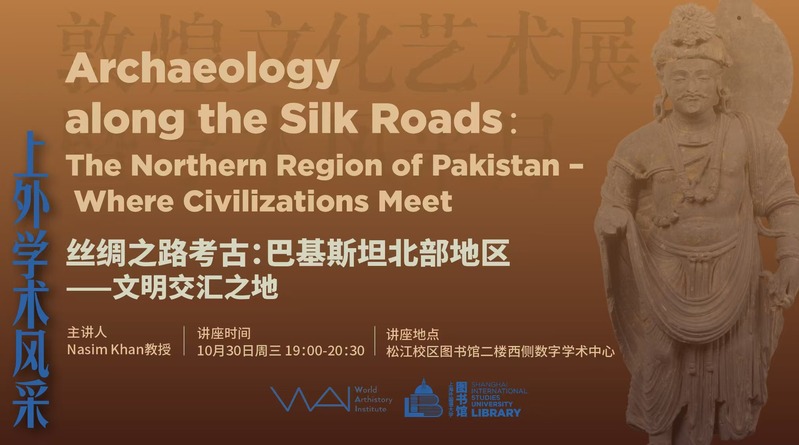敦煌是世界四大文明交汇地,境内史前文化、边塞文化、北方少数民族文化、丝绸之路文化资源丰富,是名副其实的中华民族文化资源宝库,堪称华夏文明的地理坐标。在上海外国语大学建校75周年之际,图书馆精心策划敦煌文化艺术展暨学术风采月系列活动,通过“上外学术风采”文化专栏,聚集校内外专家学者,搭建分享学术智慧、交流学术成果、探讨学术前沿的跨学科交流平台,持续助力学校以“跨、通、融”为核心的教育改革,为师生提供高质量的学术和文化滋养。

讲座信息:
Archaeology along the Silk Roads:The Northern Region of Pakistan – Where Civilizations Meet
时间:10月30日(周三)19:00-20:30
地点:松江校区图书馆二楼西侧数字学术中心
讲座语言:英文(中文字幕)
主讲人:
M.Nasim Khan|纳西姆•汗
犍陀罗研究专家,考古学家,历史语言学家
上海外国语大学世界艺术史研究所教授,博士生导师;巴基斯坦国家荣誉奖章获得者
纳西姆·汗教授熟练掌握普什图语、乌尔都语、印地语、英语、法语,并可使用旁遮普语、德语作为工作语言。在古代文字和历史语言方面,他熟练掌握佉卢文(Kharoshthi)、婆罗米文(Brahmi)、梵文(Sanskrit),能够释读夏拉达文(Sharada)、科希文(Kohi,一种尚在破译中的文字)、粟特语(Sogdian)和巴克特里亚语(Bactrian)。
讲座内容:
The archaeology of the northern region of Pakistan is as interesting as its scenic charm. Considered to be located on one of the tributaries of the Silk Road, the region is comprised of high mountains with some of the highest peaks in the world, vast glaciers and deep valleys traversed by the mighty Indus River, which gave rise to the famous Indus Valley Civilization. Despite the difficulties of access to this region in the past and even currently, for over a hundred of years, the northern regions of Pakistan have remained a crossroad and meeting point for people from different regions of the Indian subcontinent, Central Asia, China and elsewhere. This mountainous area seems to have remained not only a crossing point and a meeting place but there are indications that the area also remained a melting pot of cultures and served as a place of engagements and exchanges as suggested by archaeological discoveries in the form of rock engravings and inscriptions dating from the 2nd century BC to the 10th century AD. When exactly, why and by whom these hundred thousands of carvings have been executed, this presentation will allow us to know precisely the nature of the archaeological traces, the individuals who left these testimonies and the duration of this act. In addition, the context, role and impact of these archaeological documents on the history of the region will be discussed.
